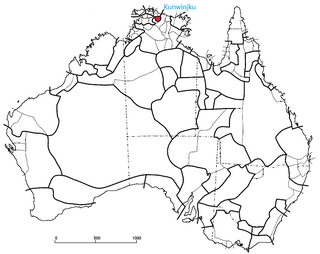Notes and references
Notes
- 1 2 3 McGregor 2002, p. 422.
- ↑ Stanner 1933, pp. 156–157.
- ↑ Stanner 1933, p. 156.
- 1 2 Ganter 2015.
- ↑ Rose 2000, p. 68.
Related Research Articles

The Kunwinjku people are an Australian Aboriginal people, one of several groups within the Bininj people, who live around West Arnhem Land to the east of Darwin, Northern Territory. Kunwinjku people generally refer to themselves as "Bininj" in much the same way that Yolŋu people refer to themselves as "Yolŋu".
The Kaantyu people are an Aboriginal Australian people of the Cape York Peninsula in north Queensland. They live in the area around the present-day town of Coen. Most of their traditional tribal land has been taken over for cattle stations. Kaantju refers to the hook of the yuli, their word for woomera.
The Mati Ke, also known as the Magatige, are an Aboriginal Australian people, whose traditional lands are located in the Wadeye area in the Northern Territory. Their language is in serious danger of extinction, but there is a language revival project under way to preserve it.
The Ngan'gimerri, also spelt Nangiomeri, Nanggumiri, and other variants, are an Aboriginal Australian people of the Daly River area in the Northern Territory.
The Madngella, otherwise known as the Matngala or Hermit Hill tribe, are an indigenous Australian people of the Northern Territory, Australia.
The Marranunggu are an Aboriginal Australian people and language group, of the Northern Territory.
The Maridan were an indigenous Australian people of the Northern Territory.
The Wadjiginy, also referred to historically as the Wogait, are an indigenous Australian people of the Northern Territory, specifically from just north of modern-day Darwin. The Wadjiginy are a saltwater people who describe themselves as wagatj 'beach-dwellers' from the Batjamalh word wagatj 'beach'.
The Wulwulam, also known as the Woolwonga, were an indigenous Australian people of the Northern Territory. They are reputed to have been almost completely exterminated in the 1880s in reprisal for an incident in which some members of the tribe speared 4 miners.
The Arnga are an Aboriginal Australian people of the northern Kimberley region of Western Australia.
The Yeidji, also spelt Yiiji and other variants, commonly known as Gwini or Kwini, are an Aboriginal Australian people of the Kimberley area of Western Australia, who also self-identify as Balanggarra.
The Ngarinman or Ngarinyman people are an Aboriginal Australian people of the Northern Territory who spoke the Ngarinyman language.
The Ngathokudi (Ngadhugudi) were an Aboriginal Australian people of the state of Queensland. Their language was possibly a dialect of Uradhi.
The Kungarakany people, also spelt Koongurrukuñ, Kungarrakany, Kungarakan and other variants, are an Aboriginal Australian people of the Northern Territory. They were called the "Paperbark People" by European settlers.
The Djerait were an indigenous Australian people of the Northern Territory
The Pongaponga were an indigenous Australian people of the Northern Territory. They may have been a band of the Ngolokwangga.
The Ngolokwangga are an Aboriginal Australian people of the Northern Territory.
The Yunggor were an Aboriginal Australian people of the Northern Territory.
The Muringura, or Murrinh-Kura, were an indigenous Australian people of the Northern Territory.
The Wagiman, also spelt Wagoman, Wagaman, Wogeman, and other variants, are an Aboriginal Australian people of the Northern Territory.
References
- Ganter, Regina (2015). "German Missionaries in Australia: Daly River (1886-1899)". Griffith University.
- McGregor, William B. (2002). Verb Classification in Australian Languages. Walter de Gruyter. ISBN 978-3-110-87087-9.
- Rose, Deborah Bird (2000). "Tropical Hundreds:monoculturalism and colonisation". In Docker, John; Fischer, Gerhard (eds.). Race, Colour and Identity in Australia and New Zealand. University of New South Wales Press. pp. 59–78. ISBN 978-0-868-40538-4.
- Stanner, W. E. H. (December 1933). "Ceremonial Economics of the Mulluk Mulluk and Madngella Tribes of the Daly River, North Australia. A Preliminary Paper". Oceania . 4 (2): 156–175. doi:10.1002/j.1834-4461.1933.tb00098.x. JSTOR 40327457.
- Stanner, W. E. H. (June 1934). "Ceremonial Economics of the Mulluk Mulluk and Madngella Tribes of the Daly River, North Australia. A Preliminary paper (continued)". Oceania . 4 (4): 458–471. doi:10.1002/j.1834-4461.1934.tb00122.x. JSTOR 27976164.